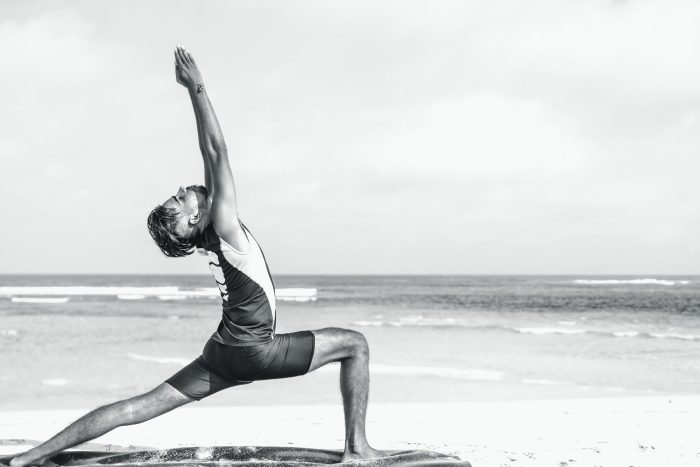Explore a curated collection of yoga asanas specifically designed to target the hips—an area of our body where trauma, fear, pain, and “emotional baggage” are easily stored.
The hip joint requires a combination of both heating and releasing postures to alleviate and relieve any issues preventing the joint from experiencing its full and fluid range of motion.
While the setup, or “architecture,” of each of these poses is important, the way that they look is not nearly as important as the way we experience our breath in each of the postures.
We should carefully monitor our inhales. When our breath feels as though it is becoming “stuck” in any particular area of our body, mindfully work to correct the imbalances by holding at the top of our inhale and sipping in just a little more air than we think our lungs can hold.
Let’s develop and maintain a rhythm with our breath—one that is both slow and meaningfully controlled—as we work to cultivate inhalations and exhalations that are equal in beat and measure.
Remember, yoga is not really about the way the poses look. It’s more about the breath becoming free.
It is recommended to begin with several rounds of Surya Namaskar—Sun Salutation—before attempting any of the following postures.
1. Malasana, Garland Pose
Beginning with our feet as wide as our mat, we lower our hips down to a low squat position in between our legs, keeping the entirety of our foot sealed to the ground. To modify, we can place a block or bolster beneath our hips and work on lengthening our spine out of our seat. Form a gentle Namaskar, with our hands to our hearts, as our elbows work to press our knees out to either side.
Additional modifications include twisting or binding each leg at a time, deepening the pose.
2. Ardha Baddha Padmottanasana, Half-Bound Lotus Standing Forward Bend
From a tall and grounded Tadasana—Mountain Pose—we bring our left foot into the crook of our right hip as if coming into a standing tree but with the sole of our foot facing outward. Reaching our left hand behind our lower back, we bind our first and second fingers to our left big toe. We gently bend forward from the waist, keeping a long spine, and guiding the pose by grounding our right hand alongside our right foot.
Let’s deepen the pose, breath by breath, finding even balance throughout our right foot, and lengthening our spine down and out of our hips.
3. Vatayanasana, The “Horse Face” Pose
From Ardha Baddha Padmottanasana, we slowly bend into our right leg, bringing the knee of our left leg to the ground (the placement of the foot in the hip does not change). Once settled, we thread our right arm underneath our left and raise our elbows to the height of our shoulders. We stay with even breath.
4. Marichyasana B, Second Pose Dedicated to the Sage Marichi
From Vatayanasana, we lower into a seat, keeping the bind of our left foot to our right hip. We bend our right leg, bringing the sole of our right foot alongside our lowered left knee. Adjust the pose as necessary to keep our hips level and our seat even. Option to bind our right leg, keeping a long spine, and lengthening our upper body forward. We reach our third eye forward to the earth.
5. Virasana, Hero Pose
Bending both of our knees, we gather our feet alongside the outer edges of our hips, with the soles of our feet facing upward. If we can, rest a seat comfortably in-between our feet, we lower our upper body down and back, walking our elbows back to support the opening of our heart.
We modify the pose by placing a block underneath our hips and staying upright if our knees do not allow us to arch back. If we are folding back, let’s express our chest upward as we arch our spine to drop our head back. Another deep expression of this pose involves resting the entirety of our spine on the ground, reaching arms overhead.
Stay for several deep rounds of breath.
6. Setu Bandha Sarvangasana, Shoulder-Supported Bridge Pose
We start on our back, bringing the soles of our feet to the ground, hip-width apart. We distance our feet below our knees so that our fingertips just graze the back of each heel. We knit our shoulders together by interlacing our hands together below our lower back and pulling our grip in tight.
We tuck into our body by nestling our chin into our chest. We elevate our hips up off our mat on an inhale, and stay for five to seven rounds of breath.
We can reach our hips higher on every inhale and ground down into our shoulder base and through our feet on every exhale.
7. Urdhva Padmasana in Sirsasana/Sarvangasana, Lotus Legs in Headstand or Shoulderstand
Sarvangasana variation: from Setu Bandha Sarvangasana, we bring our legs up into the air, elevating them as high as possible, directly over our hips. We gently guide our spine up and off of our mat, supporting our lower back with our hands, as our elbows rest alongside our bodies. Bring one foot into the crook of the opposite hip at a time, as in Ardha Baddha Padmottanasana, to find the full Padmasana—Lotus—variation.
Stay for 10-20 rounds of breath.
Sirsasana variation: Set up a stable headstand with our elbows shoulder-width apart and the crown of our head hovering in-between our interlaced fingers. We bring our legs upward and overhead, lengthening our spine fully and engaging our inner thighs and abdomen. Slowly lower one foot in toward the opposite hip crease at a time, as in Ardha Baddha Padmottanasana, to find full Padmasana—Lotus—variation.
Stay for 10-20 rounds of breaths.
8. Supta Baddha Konasana, Reclining Bound Angle Pose
Lying down with our spine long on our mat, we bring the soles of our feet together just below our hips. We rest our left hand over our heart and our right hand below our ribs. We breathe deeply into our belly and hips, filling up our lungs with as much air as we possibly can as our stomach gently rises. For more intensity, we draw our heels in close to our pelvis, splaying our knees wide. For less intensity, we can distance our feet further away from our body.
Let’s stay for 20 deep breaths, lengthening our breath on each inhalation and exhalation.
Namaste.
~







Read 1 comment and reply